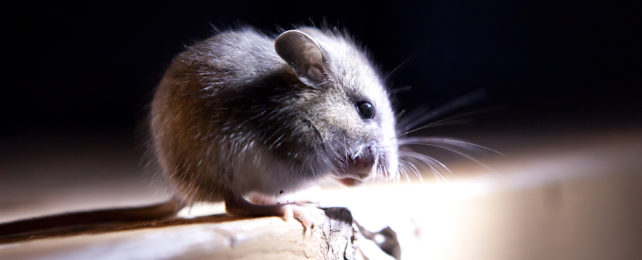Watching somebody relieve an itch with a delightful old scratch can have you dragging your nails over your skin as quick as you can say, "Aaaaah … that's the spot."
Contagious scratching isn't unique to humans, either. Mice have very similar reactions upon seeing their fellow rodents dig in. A recent study on mice scratching themselves has now revealed something unusual about this social phenomenon in the tiny rodents.
The physiological process of being inspired to scratch after 'seeing' the action being performed by another doesn't involve the brain's visual processing hardware.
This means when one rodent scratches its itch, nearby mice will follow suit, even if the scratching behavior isn't registered as pictures in their mind.
That might sound like a made-up superpower, but even in humans, there are elusive pathways that allow us to 'see' and respond to visual stimuli when the visual cortex, which processes that visual information, is damaged.
The phenomenon is known as 'blindsight', or unconscious vision, and recent research suggests it's based on a subcortical pathway that carries information from the eyes to the other parts of the brain while bypassing the visual cortex completely.
It's essentially a neural shortcut that can allow someone who is fully blind to walk down a hallway while avoiding obstructions that they cannot consciously see, as seen in the video below.
A similar pathway might alert mice to a blind itch. When researchers disabled the visual cortex in lab mice, the test animals still scratched themselves when they saw a video of another mouse doing the same.
Recordings of the activity of mice brain cells suggest the 'itching contagion' starts with specialized light-sensitive cells in the retina, called intrinsically photosensitive retinal ganglion cells (ipRGC).
These lesser-known retinal cells connect directly to a tiny brain region responsible for triggering a neurological scratching cascade, known as the suprachiasmatic nucleus (SCN). Deep within the brain, the subcortical pathway allows light to set the circadian clock without the need for light stimuli to be visually interpreted as an image.
In the past, some scientists have actually speculated that ipRGCs play a potential role in human blindsight, although that has yet to be determined.
While ipRGCs might contribute to vision in some ways, the current textbook view is that they fall short of painting a scene. And yet this new research on mice suggests otherwise.
In mouse models, when ipRGC's were stopped from sending signals, the animals no longer showed contagious scratching behaviors, even when researchers kept their visual systems intact.
"This contagious itch – which is a reflex response in mice, just as grooming is – must be somehow important for survival," concludes neurobiologist Zhou-Feng Chen from Washington University in St Louis.
"We humans also experience contagious itch, but we have found that in mice such itching is controlled through a pathway that was not known to be responsible for 'seeing' things. That could mean this sort of imitative scratching behavior is an ancient, protective behavior."
Chen compares it to a frog catching an insect. Frogs lack the same neurological wiring for interpreting vision present in mammals, but their eyes still send information about light to other parts of their brain via retinal ganglion cells.
Given how quickly a frog's prey can fly, these ganglion cells are particularly sensitive to movement. When a fly buzzes nearby, a frog's sticky tongues seem to know exactly where to go.
Mice have a similar reflex, it appears, but for sensing their companions' scratching without the need to take the time and trouble of recruiting the level of neurology required to turn it into a visual impression.
While it's not clear why contagious scratching might work this way in mice, mindlessly responding to any kind of threat on cue could give social animals a competitive edge.
What's more, the researchers suggest contagious behavior of this sort might be a primitive form of emotional contagion. In other words, it may not be a coincidence that the newly discovered ipRGC pathway in mice is connected to the thalamus, the brain's seat for relaying sensory information, which has also recently been implicated in processing emotional stimuli.
Stress, after all, is a feeling of emotional tension. And itches are nothing if not stressful.
In the current study, when mice were shown videos of other scratching mice, the level of the stress hormone cortisol increased in their blood. This stress response suggests that itch contagion conveys information about another animal's distress, rather than being a form of motor mimicry.
"In humans, the pathway for contagious itch may be different from what we've seen in mice," says Chen.
"It's likely the human response requires the visual cortex. But in people, contagious itch may be just an evolutionary remnant. You have to go back to animals, like these mice, to learn why these types of behaviors may once have been, or may still be, important to survival."
Aside from ipRCGs, other researchers have pointed to mirror neurons – brain cells that are active when we imitate actions or negative affect – having a role in the contagiousness of human scratching.
Future studies will need to compare other mammals to make more sense of these pathways and their evolutionary history.
"This kind of contagious behavior is widespread in the animal world," says Chen.
The study was published in Cell Reports.
